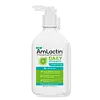What's inside
What's inside
 Key Ingredients
Key Ingredients

 Benefits
Benefits

 Concerns
Concerns

 Ingredients Side-by-side
Ingredients Side-by-side

Paraffinum Liquidum
EmollientOctyldodecanol
EmollientCaprylic/Capric Triglyceride
MaskingIsopropyl Palmitate
EmollientSodium Lactate
BufferingUrea
BufferingGlycerin
HumectantPEG-7 Hydrogenated Castor Oil
EmulsifyingBenzyl Alcohol
PerfumingDimethicone
EmollientMethoxy PEG-22/Dodecyl Glycol Copolymer
Emulsion StabilisingPEG-45/Dodecyl Glycol Copolymer
Emulsion StabilisingMagnesium Sulfate
Lactic Acid
BufferingMicrocrystalline Wax
Emulsion StabilisingPEG-2 Hydrogenated Castor Oil
EmulsifyingSorbitan Isostearate
EmulsifyingParaffinum Liquidum, Octyldodecanol, Caprylic/Capric Triglyceride, Isopropyl Palmitate, Sodium Lactate, Urea, Glycerin, PEG-7 Hydrogenated Castor Oil, Benzyl Alcohol, Dimethicone, Methoxy PEG-22/Dodecyl Glycol Copolymer, PEG-45/Dodecyl Glycol Copolymer, Magnesium Sulfate, Lactic Acid, Microcrystalline Wax, PEG-2 Hydrogenated Castor Oil, Sorbitan Isostearate
Water
Skin ConditioningAmmonium Lactate
BufferingSqualane
EmollientNiacinamide
SmoothingCetearyl Alcohol
EmollientGlycerin
HumectantPropanediol
SolventCoconut Alkanes
EmollientSodium Lactate
BufferingPotassium Lactate
BufferingCandelilla/Jojoba/Rice Bran Polyglyceryl-3 Esters
EmulsifyingGlyceryl Stearate
EmollientCholecalciferol
Tocopheryl Acetate
AntioxidantCeramide NP
Skin ConditioningCeramide AP
Skin ConditioningCeramide EOP
Skin ConditioningGlycereth-5 Lactate
EmollientCholesterol
EmollientCoco-Caprylate/Caprate
EmollientPhytosphingosine
Skin ConditioningXanthan Gum
EmulsifyingHydroxyethyl Acrylate/Sodium Acryloyldimethyl Taurate Copolymer
Emulsion StabilisingSodium Stearoyl Lactylate
EmulsifyingPEG-7 Trimethylolpropane Coconut Ether
EmulsifyingEthylhexylglycerin
Skin ConditioningSodium Lauroyl Lactylate
EmulsifyingPolyisobutene
Phenoxyethanol
PreservativeCarbomer
Emulsion StabilisingPolysorbate 60
EmulsifyingWater, Ammonium Lactate, Squalane, Niacinamide, Cetearyl Alcohol, Glycerin, Propanediol, Coconut Alkanes, Sodium Lactate, Potassium Lactate, Candelilla/Jojoba/Rice Bran Polyglyceryl-3 Esters, Glyceryl Stearate, Cholecalciferol, Tocopheryl Acetate, Ceramide NP, Ceramide AP, Ceramide EOP, Glycereth-5 Lactate, Cholesterol, Coco-Caprylate/Caprate, Phytosphingosine, Xanthan Gum, Hydroxyethyl Acrylate/Sodium Acryloyldimethyl Taurate Copolymer, Sodium Stearoyl Lactylate, PEG-7 Trimethylolpropane Coconut Ether, Ethylhexylglycerin, Sodium Lauroyl Lactylate, Polyisobutene, Phenoxyethanol, Carbomer, Polysorbate 60
Ingredients Explained
These ingredients are found in both products.
Ingredients higher up in an ingredient list are typically present in a larger amount.
Glycerin is already naturally found in your skin. It helps moisturize and protect your skin.
A study from 2016 found glycerin to be more effective as a humectant than AHAs and hyaluronic acid.
As a humectant, it helps the skin stay hydrated by pulling moisture to your skin. The low molecular weight of glycerin allows it to pull moisture into the deeper layers of your skin.
Hydrated skin improves your skin barrier; Your skin barrier helps protect against irritants and bacteria.
Glycerin has also been found to have antimicrobial and antiviral properties. Due to these properties, glycerin is often used in wound and burn treatments.
In cosmetics, glycerin is usually derived from plants such as soybean or palm. However, it can also be sourced from animals, such as tallow or animal fat.
This ingredient is organic, colorless, odorless, and non-toxic.
Glycerin is the name for this ingredient in American English. British English uses Glycerol/Glycerine.
Learn more about GlycerinSodium Lactate is the sodium salt of lactic acid, an AHA. It is a humectant and sometimes used to adjust the pH of a product.
This ingredient is part of our skin's NMF, or natural moisturizing factor. Our NMF is essential for the hydration of our top skin layers and plasticity of skin. NMF also influences our skin's natural acid mantle and pH, which protects our skin from harmful bacteria.
High percentages of Sodium Lactate can have an exfoliating effect.
Fun fact: Sodium Lactate is produced from fermented sugar.
Learn more about Sodium Lactate